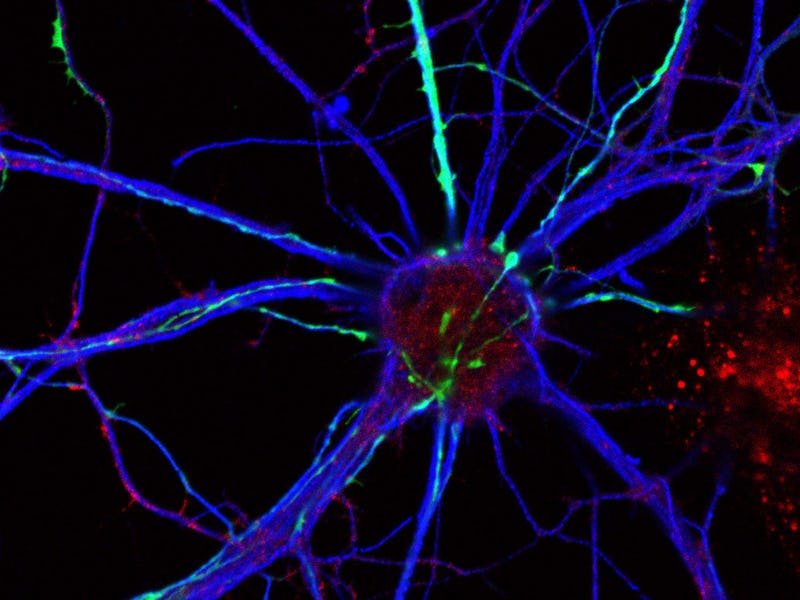Light in the Attic: How Optogenetics Make Transhuman Brain Hacking Possible
We can engineer cells to emit light and react to it, which means we can likely do a whole lot of other stuff as well.

Biology is a lot like Legos because, metaphorically speaking, everything is a lot like Legos. The truth is that our bodies, our seemingly cohesive wholes, actually consists of innumerable small parts and that mixing and matching functions is fleshy, bloody, and not that difficult. For example — and to get this logical train rolling — you can manufacture snap into place neurons capable of generating and respond to light, thereby establishing a brand new neurotransmitter system that does not interfere with existing systems, a brain on top of the brain.
This is the idea at the heart (or head or whatever) of the new field of optogenetics. Like so many other tools in biology, optogenetics is based on the biology of another organism that was “borrowed.” In this case, it’s a protein called channelrhodopsin-2 (ChR-2), and it came from the green algae called Chlamydomonas reinhardtii. It turns out there are many light-sensitive ion channels like this one. The idea is to build new biological systems based on ChR-2 brick by brick.
Since Karl Deisseroth engineered mammalian neurons that were grown in the lab to express ChR-2 in 2005, many researchers have tinkered with optogenetics, using it to figure out which neurons do what. For example, one type of neuron – called neocortical parvalbumin neurons – modulates 40-cycles-per-second rhythms in the brain (“gamma oscillations”). It has been known for some time that gamma oscillations are abnormal in both schizophrenic and autistic patients, so new strategies to investigate and potentially correct these cells is currently underway. This is a particularly intriguing strategy. Even if the individual’s underlying genetics produces an abnormal result in these cells, if scientists can simply override that result, then those genetics wouldn’t matter.
More recently, scientists have also begun experimenting with the idea of creating optogenetic networks using bioluminescent cells. In particular, the focus is on the type of bioluminescence discovered by Osamu Shimomura in 1962, which is from the jellyfish Aequorea victoria and reacts to light (Shimomura got a Nobel for his research). Light creating cells and light-sensitive cells are — to reiterate the metaphor — like the dual sides of a Lego.
People look at the Jellyfish display at the EPSON Aqua Park Shinagawa. The animal and fish displays have been enhanced with high-tech neon lights, touch screens and audiovisual shows.
By encouraging interactions between these two cell types, scientists might be able to achieve unprecedented levels of neuronal precision. They’ll also be able to get optogenetic cells to respond to light without gluing a flashlight to a mouse’s head, which is cool — especially for the mouse.
But what about applications? One possibility is to make the very cells that respond to light, generate it. So when they’re biological function kicks in – say they produce leptin or ghrelin, and therefore regulate your appetite – they would also light up and trigger the system. By doing this, scientists could potentially dial back the amount of ghrelin produced so people get less hungry less often. Or they could tweak the amount of insulin released in response to blood sugar cues. Or they could flood the zone with adrenaline when subjects get tired.
Alternatively, one could hack existing systems. For example, by optogenetically engineer inhibitory neurons in the amygdala to respond to light, and activating neurons in the amygdala to produce light researchers could rewire peoples’ inhibitor neurons to overwhelm their sense of stress or anxiety. No more anxiety. (This might well lead to a jump in joblessness as people sort of wander off to pursue their joy.)
Dramatization of two neurons in a network generating their own green light
We could get fancier still: Perhaps we could devise a system in which each neuron in the network expresses its own color, and the optogenetic cells require activation of every channel for their effect to be realized. So instead of a single neuron firing, an entire memory has to be activated in order for the system to work. Maybe the bad effects of certain memories could be attenuated. Or the whole thing could be made to respond to a drug so it’s capable of being turned on or off by the user.
In any case, there are still major scientific and regulatory hurdles before this sci-fi rewiring starts in earnest. To put things in perspective, the FDA has yet to approve any gene therapy procedures, and only one procedure has been approved in Europe. This stuff is a long way off.
But it’s coming.
And it’s not lost on researchers that optogenetic cells could also work with hardware — that we can not only hack our systems using these emerging technologies, but plug ourselves into larger system. Biology is like Legos, but it’s less like Legos than it could be. Expect that to change.